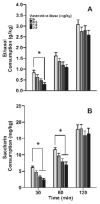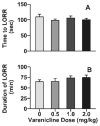Varenicline modulates ethanol and saccharin consumption in adolescent male and female C57BL/6J mice
- PMID: 28778837
- PMCID: PMC5794646
- DOI: 10.1016/j.brainresbull.2017.07.020
Varenicline modulates ethanol and saccharin consumption in adolescent male and female C57BL/6J mice
Abstract
Adolescence is a critical period in brain development that coincides with the initiation of alcohol use. Nicotinic acetylcholine receptors (nAChR) have been shown to modulate ethanol behaviors in adult humans and in animal models; however, the role of these receptors in adolescent ethanol behaviors has not been explored. Throughout adolescence, nAChR expression undergoes large-scale developmental changes which may alter behavioral responses to ethanol. Here we examined the effect of varenicline, a nAChR partial agonist, on ethanol consumption, ataxia, sedation, and metabolism in adolescent male and female C57BL/6J mice. The effect of varenicline on ethanol consumption was tested through the Drinking-in-the-Dark (DID) paradigm that models binge-like ethanol consumption. To ensure that results were specific for ethanol, we also tested the effect of varenicline on saccharin consumption. Additionally, varenicline was administered 30min prior to an acute injection of ethanol before being tested for ataxia on the balance beam, sedation using the loss of righting reflex, or ethanol metabolism. Varenicline dose dependently decreased ethanol consumption, but also influenced saccharin intake. Varenicline showed no significant effect on ethanol metabolism, ataxia, or sedation. Unlike its effects in adult animals, varenicline is able to reduce ethanol consumption without increasing the ataxic and sedative effects of ethanol. This work suggests that the neurobiological mechanisms of ethanol behaviors may change across the lifespan and highlights the need for more research on the role of nAChRs in ethanol behaviors throughout development.
Keywords: Ataxia; Consumption; Ethanol; Nicotinic acetylcholine receptors; Sedation; Varenicline.
Copyright © 2017 Elsevier Inc. All rights reserved.
Figures




Similar articles
-
The nicotinic acetylcholine receptor partial agonist varenicline increases the ataxic and sedative-hypnotic effects of acute ethanol administration in C57BL/6J mice.Alcohol Clin Exp Res. 2010 Dec;34(12):2053-60. doi: 10.1111/j.1530-0277.2010.01301.x. Epub 2010 Oct 14. Alcohol Clin Exp Res. 2010. PMID: 20946306 Free PMC article.
-
Modulation of ethanol consumption by genetic and pharmacological manipulation of nicotinic acetylcholine receptors in mice.Psychopharmacology (Berl). 2010 Mar;208(4):613-26. doi: 10.1007/s00213-009-1759-1. Psychopharmacology (Berl). 2010. PMID: 20072781 Free PMC article.
-
Genetic and pharmacological manipulation of glyoxalase 1 regulates voluntary ethanol consumption in mice.Addict Biol. 2017 Mar;22(2):381-389. doi: 10.1111/adb.12333. Epub 2015 Dec 22. Addict Biol. 2017. PMID: 26691867 Free PMC article.
-
α6β2 nicotinic acetylcholine receptors influence locomotor activity and ethanol consumption.Alcohol. 2017 Jun;61:43-49. doi: 10.1016/j.alcohol.2017.02.178. Epub 2017 Apr 27. Alcohol. 2017. PMID: 28457669 Free PMC article.
-
The Impact of Varenicline on Alcohol Consumption in Subjects With Alcohol Use Disorders: Systematic Review and Meta-Analyses.J Clin Psychiatry. 2020 Feb 25;81(2):19r12924. doi: 10.4088/JCP.19r12924. J Clin Psychiatry. 2020. PMID: 32097546
Cited by
-
The role of nicotinic acetylcholine receptors in alcohol-related behaviors.Brain Res Bull. 2020 Oct;163:135-142. doi: 10.1016/j.brainresbull.2020.07.017. Epub 2020 Jul 22. Brain Res Bull. 2020. PMID: 32707263 Free PMC article. Review.
-
Adolescent alcohol and nicotine exposure alters the adult response to alcohol use.Adv Drug Alcohol Res. 2023 Nov 22;3:11880. doi: 10.3389/adar.2023.11880. eCollection 2023. Adv Drug Alcohol Res. 2023. PMID: 38389816 Free PMC article. Review.
-
An improved model of ethanol and nicotine co-use in female P rats: Effects of naltrexone, varenicline, and the selective nicotinic α6β2* antagonist r-bPiDI.Drug Alcohol Depend. 2018 Dec 1;193:154-161. doi: 10.1016/j.drugalcdep.2018.09.008. Epub 2018 Oct 17. Drug Alcohol Depend. 2018. PMID: 30384323 Free PMC article.
-
Midazolam, methamphetamine, morphine and nicotine intake in high-drinking-in-the-dark mice.Addict Biol. 2022 Sep;27(5):e13212. doi: 10.1111/adb.13212. Addict Biol. 2022. PMID: 36001437 Free PMC article.
-
Mecamylamine Reverses the Effects of Cytisine on the Oral Self-administration of Ethanol in Rats.Basic Clin Neurosci. 2024 Jul-Aug;15(4):489-498. doi: 10.32598/bcn.2023.4730.1. Epub 2024 Jul 1. Basic Clin Neurosci. 2024. PMID: 39553261 Free PMC article.
References
-
- Bowers BJ, McClure-Begley TD, Keller JJ, Paylor R, Collins AC, Wehner JM. Deletion of the alpha7 nicotinic receptor subunit gene results in increased sensitivity to several behavioral effects produced by alcohol. Alcohol Clin Exp Res. 2005;29:295–302. - PubMed
-
- Coe JW, Brooks PR, Vetelino MG, Wirtz MC, Arnold EP, Huang J, Sands SB, Davis TI, Lebel LA, Fox CB, Shrikhande A, Heym JH, Schaeffer E, Rollema H, Lu Y, Mansbach RS, Chambers LK, Rovetti CC, Schulz DW, Tingley FD, 3rd, O'Neill BT. Varenicline: an alpha4beta2 nicotinic receptor partial agonist for smoking cessation. J Med Chem. 2005;48:3474–3477. doi: 10.1021/jm050069n. - DOI - PubMed
Publication types
MeSH terms
Substances
Grants and funding
LinkOut - more resources
Full Text Sources
Other Literature Sources
Medical

